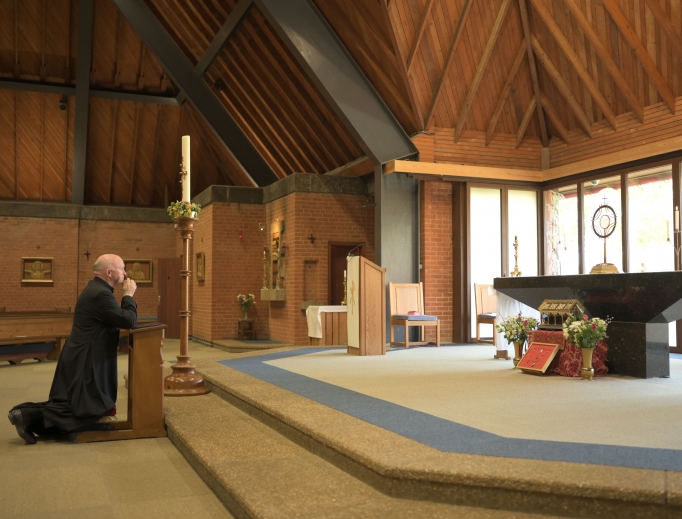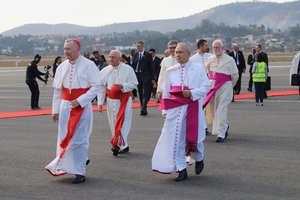In a Time of Contagion: Walsingham and the Rededication of England
As his tenure ends, the shrine’s rector reflects on momentous events.

The 2020 rededication of England as Mary’s Dowry was a different occasion than the one originally envisaged. This national act of piety was to have been accompanied by ceremonies and public prayers in churches and cathedrals up and down the land.
COVID-19 put a stop to that.
What the pandemic could not do, however, was halt the rededication taking place. In the end, the rededication was to occur in a more intimate and personal way than could ever have been planned three years earlier when it was first proposed.
At noon on March 29, England was once more given to Mary as her “Dowry.” Walsingham, the principal English Marian shrine, known as England’s Nazareth, was always going to be central to that act of rededication. More than 500,000 virtual pilgrims from all over the world decided to join the simple rededication prayer that took place at the shrine. So many were the numbers of “pilgrims” that the shrine’s server crashed.
Curiously, these half a million souls were far more numerous than could ever have been anticipated physically coming to the shrine at Walsingham had the rededication happened in the manner originally planned. The priest who led the historic rededication of England to Our Lady at Walsingham was the shrine’s rector, Msgr. John Armitage. As it turns out, this summer will mark the end of his five years serving at the shrine.
On April 14, Msgr. Armitage spoke to the Register about the rededication of England as Mary’s Dowry and about the unforeseen and unprecedented times in which he exercises his ministry in these last weeks at Walsingham.
“Five years ago I was asked to come here and develop the shrine,” he said, “and I thought that my time here would be about putting up new buildings and renovating old ones. But like Richeldis de Faverches my plans didn’t fit with what Our Lady wants us to understand as the true message of Walsingham. It’s a clear message — if one largely forgotten — namely: to share in her joy at the Annunciation. Our Lady was clear about what Richeldis had to do [to build a model of Mary’s house at Nazareth where the Annunication took place], but she was equally clear that this mission was not about buildings, per se, but about joy — a reality that is still important today.”
E-pilgrimage to Walsingham
Although Msgr. Armitage felt a certain sadness that no pilgrims could come to Walsingham last month for the rededication of England as Mary’s Dowry, he observed: “We may have had no pilgrims at the shrine [on that day], but in its 1,000-year history, the shrine, on March 29, saw the biggest pilgrimage ever — albeit one that took place in people’s homes: a virtual pilgrimage.”
The word “joy” feels like a distant concept in these days of pandemic, but Msgr. Armitage is quick to counter any temptation to despondency among the faithful in these days of widespread coronavirus lockdown. “There is a difference between joy and happiness,” he said. “Joy never leaves us. It is a consequence of the gift given us; that is: the joy of the Gospel.” He continued to reflect on the shrine’s troubled history and, in turn, to relate that to the current predicament. “Buildings get destroyed, but the message of Walsingham lives on. At this moment of England’s rededication to Our Lady, I feel we have once again started to listen to that message. It is as if the prophecy of Pope Leo XIII (1878-1903) — ‘When England comes back to Walsingham, Our Lady will return to England’ — was fulfilled on March 29, 2020.”
So in what ways has the Walsingham shrine, a place synonymous with many and diverse pilgrimages from all over the British Isles, remained relevant to people at a time when the world must stay at home? “I would say that, like everyone else, we have had to close all physical operations,” Msgr. Armitage replied. “We have had to get our head around being a ‘virtual shrine.’ In some ways that challenge is no different from that faced by all parishes at this moment. Essentially, it is the difference between the material and the spiritual. Normally, when we go to the church to pray, it is both a spiritual and material experience.
“Now, we have had our eyes opened to the spiritual — making spiritual communions, for example,” he continued. “One of the ancient prayers of Walsingham speaks of Our Lady conceiving God in her heart before she conceived him in her womb. Most important now are these spiritual experiences. As long as the spiritual desire for God is within us, then God will respond to that.”
What, if any, have been some of the reactions of Walsingham’s virtual pilgrims?
“Attendance at the shrine services online began small but is now much larger. For the past five years we have had livestreamed services from the shrine, mainly for the housebound — for people who have, in some cases, been housebound for years, for some who have been in ‘lockdown’ permanently. Now, they feel as much part of things as everyone else. Today that wider congregation has gone from 100s to 1,000s, to the 500,000 at the rededication — so many the website crashed! In Holy Week alone we had numbers watching at around 240,000 from 124 different countries, from the U.S. to Afghanistan.”
Walsingham’s Bandwidth
Msgr. Armitage sees the engagement with this growing band of virtual pilgrims as an opportunity to promote the message of Walsingham, a message that has never been more relevant. In his interaction with these virtual pilgrims via emails and telephone calls, he is aware that many are asking “deep questions” about the world and their place in it. He sees this new searching as mysteriously linked to the rededication of England as Mary’s Dowry.
“If we go back to the beginning of the story of Walsingham, Our Lady shows what she wants from Richeldis in regards to the Holy House. However, when Richeldis returns to Walsingham to build the house, she can’t quite get it right. The construction of the house that she set in motion didn’t work. Then Richeldis spends the night in prayer, and the next morning it is Our Lady and the angels who have built the house.”
He paused, and then continued, “I should have remembered that. Our Lady’s message is leading us to her Son. The rededication was planned three years ago. Of course, we could not have imagined what would happen. When I look back now, all our attempts to make arrangements for the rededication didn’t fit together — didn’t work — just like Richeldis’ attempts. Conferences, tours, books and articles, we were even ready to go into the Houses of Parliament with the statue of Our Lady of Walsingham. But, somehow, it didn’t fit together. Instead, Our Lady wanted us to make the dedication in the midst of this storm.”
Turning to England’s most recently canonized saint, Msgr. Armitage noted, “St. John Henry Newman said that it is according to our need, so shall be our strength. Our Lady shows us this now. She knew this particular need [of learning to live in lockdown, and of practicing our faith without access physically to churches] was coming. And it was in this time that she asked us to make this rededication.”

Gift Exchange
Some still wonder what the difference is between consecration and dedication and what exactly this latest dedication means?
“‘Consecration’ means to be made holy, and we become holy by being consecrated,” explained Msgr. Armitage. “The consecration took place on the feast of the Annunciation, when it is about what God gives to us. ‘Dedication’ is about what we do for God. So the rededication is about what we do for God. If we ever needed a moment when we took that concept seriously, then it was March 29, 2020, [the date of the latest rededication].”
In the end, Msgr. Armitage sees the rededication of each one of us expressed in the simplicity of the prayer of the Annunciation, in Mary’s Fiat: namely, in a simple “Yes” to God’s will in our lives.
At a time when national governments are asking for ongoing resilience from their populations in the face of the pandemic, the Church, Msgr. Armitage suggested, is asking for spiritual resilience from the faithful.
“Our Lady conceived Christ in her heart and then she had the Child. We need to have that same spiritual strength [of Mary], but we also know that we have to draw this from a greater strength than ourselves. In the end, we must seek this spiritual strength that helps us [to say ‘Yes’ to God’s will].”
Christ Risen — in England, Too
Speaking in the Easter Octave, perhaps the most poignant one of modern times, what does Msgr. Armitage think the message of Walsingham has to say to the wider world in lockdown? Msgr. Armitage points out that the first thing to remember is that, initially at least, in the post-Resurrection world, the disciples did not recognize Our Lord.
Reflecting on our own times, Msgr. Armitage said, “If you see the world through what Pope John Paul II called the ‘culture of death,’ of greed and corruption, it will take us time to see the Resurrection.”
Standing in a still and empty Walsingham shrine, Msgr. Armitage concluded with these words: “As Pope Francis said: We are living not in an era of change but in a change of era. Nevertheless, the question remains: Will our eyes be open to see it? In the midst of one of the greatest challenges to mankind, it will take a while for [some of] us to become aware that Christ is truly risen from the dead.”
K.V. Turley is the Register’s U.K. correspondent.
- Keywords:
- coronavirus
- k.v. turley
- our lady of walsingham

















